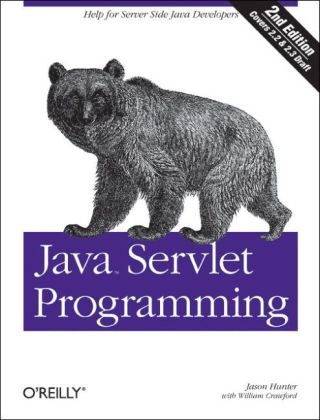Share
Fr. 66.00
William Crawford, Jason Hunter, Hunter Jason
Java Servlet Programming
English · Paperback / Softback
Shipping usually within 3 to 5 weeks
Description
Servlets are an exciting and important technology that ties Java to the Web, allowing programmers to write Java programs that create dynamic web content.
Java Servlet Programming covers everything Java developers need to know to write effective servlets. It explains the servlet lifecycle, showing how to use servlets to maintain state information effortlessly. It also describes how to serve dynamic web content, including both HTML pages and multimedia data, and explores more advanced topics like integrated session tracking, efficient database connectivity using JDBC, applet-servlet communicaton, interservlet communication, and internationalization. Readers can use the book's numerous real-world examples as the basis for their own servlets.
The second edition has been completely updated to cover the new features of Version 2.2 of the Java Servlet API. It introduces chapters on servlet security and advanced communication, and also introduces several popular tools for easier integration of servlet technology with dynamic web pages. These tools include JavaServer Pages (JSP), Tea, XMLC, and the Element Construction Set.
In addition to complete coverage of 2.2 specification, Java Servlet programming, 2nd Edition, also contains coverage of the new 2.3 final draft specification.
List of contents
Preface;
Servlet API 2.2;
Readers of the First Edition;
Audience;
About the Examples;
Organization;
Conventions Used in This Book;
Request for Comments;
Acknowledgments;
Acknowledgments from the First Edition;
Chapter 1: Introduction;
1.1 History of Web Applications;
1.2 Support for Servlets;
1.3 The Power of Servlets;
Chapter 2: HTTP Servlet Basics;
2.1 HTTP Basics;
2.2 The Servlet API;
2.3 Page Generation;
2.4 Web Applications;
2.5 Moving On;
Chapter 3: The Servlet Lifecycle;
3.1 The Servlet Alternative;
3.2 Servlet Reloading;
3.3 Init and Destroy;
3.4 Single-Thread Model;
3.5 Background Processing;
3.6 Load on Startup;
3.7 Client-Side Caching;
3.8 Server-Side Caching;
Chapter 4: Retrieving Information;
4.1 The Servlet;
4.2 The Server;
4.3 The Client;
Chapter 5: Sending HTML Information;
5.1 The Structure of a Response;
5.2 Sending a Normal Response;
5.3 Using Persistent Connections;
5.4 Response Buffering;
5.5 Status Codes;
5.6 HTTP Headers;
5.7 When Things Go Wrong;
5.8 Six Ways to Skin a Servlet Cat;
Chapter 6: Sending Multimedia Content;
6.1 WAP and WML;
6.2 Images;
6.3 Compressed Content;
6.4 Server Push;
Chapter 7: Session Tracking;
7.1 User Authentication;
7.2 Hidden Form Fields;
7.3 URL Rewriting;
7.4 Persistent Cookies;
7.5 The Session Tracking API;
Chapter 8: Security;
8.1 HTTP Authentication;
8.2 Form-Based Authentication;
8.3 Custom Authentication;
8.4 Digital Certificates;
8.5 Secure Sockets Layer (SSL);
Chapter 9: Database Connectivity;
9.1 Relational Databases;
9.2 The JDBC API;
9.3 Reusing Database Objects;
9.4 Transactions;
9.5 A Guestbook Servlet;
9.6 Advanced JDBC Techniques;
9.7 Beyond the Core;
Chapter 10: Applet-Servlet Communication;
10.1 Communication Options;
10.2 Daytime Server;
10.3 Chat Server;
Chapter 11: Servlet Collaboration;
11.1 Sharing Information;
11.2 Sharing Control;
Chapter 12: Enterprise Servletsand J2EE;
12.1 Distributing Load;
12.2 Integrating with J2EE;
Chapter 13: Internationalization;
13.1 Western European Languages;
13.2 Conforming to Local Customs;
13.3 Non-Western European Languages;
13.4 Multiple Languages;
13.5 Dynamic Language Negotiation;
13.6 HTML Forms;
Chapter 14: The Tea Framework;
14.1 The Tea Language;
14.2 Getting Started;
14.3 Request Information;
14.4 Tea Administration;
14.5 Tea Applications;
14.6 A Tool Application;
14.7 Final Words;
Chapter 15: WebMacro;
15.1 The WebMacro Framework;
15.2 Installing WebMacro;
15.3 WebMacro Directives;
15.4 WebMacro Templates;
15.5 A Tool Application;
15.6 Filters;
Chapter 16: Element Construction Set;
16.1 Page Components as Objects;
16.2 Displaying a Result Set;
Chapter 17: XMLC;
17.1 A Simple XML Compile;
17.2 The Manipulation Class;
17.3 A Tool Application;
Chapter 18: JavaServer Pages;
18.1 Using JavaServer Pages;
18.2 Behind the Scenes;
18.3 Expressions and Declarations;
18.4 Directives;
18.5 JSP and JavaBeans;
18.6 Includes and Forwards;
18.7 A Tool Application;
18.8 Custom Tag Libraries;
Chapter 19: Odds and Ends;
19.1 Parsing Parameters;
19.2 Sending Email;
19.3 Using Regular Expressions;
19.4 Executing Programs;
19.5 Using Native Methods;
19.6 Acting as an RMI Client;
19.7 Debugging;
19.8 Performance Tuning;
Chapter 20: What's New in the Servlet 2.3 API;
20.1 Changes in the Servlet API 2.3;
20.2 Conclusion;
Servlet API Quick Reference;
HTTP Servlet API Quick Reference;
Deployment Descriptor DTD Reference;
HTTP Status Codes;
Character Entities;
Charsets;
Colophon;
About the author
Summary
This new edition of this book has been updated to add the new features of the Java Servlet API Version 2.2, and new chapters on servlet security and advanced communication. It also introduces several popular tools including JavaServer Pages (JSP), Tea, XMLC, and the Element Construction Set.
Product details
| Authors | William Crawford, Jason Hunter, Hunter Jason |
| Publisher | O'Reilly Media |
| Languages | English |
| Product format | Paperback / Softback |
| Released | 01.01.2001 |
| EAN | 9780596000400 |
| ISBN | 978-0-596-00040-0 |
| No. of pages | 753 |
| Weight | 1130 g |
| Series |
Java (O'Reilly) Java Java (O'Reilly) Java S. |
| Subjects |
Natural sciences, medicine, IT, technology
> IT, data processing
> Programming languages
Java (Web Programmierung), Programmier- und Skriptsprachen, allgemein, Programming and scripting languages: general, COMPUTERS / Internet / Web Programming, COMPUTERS / Languages / General, Java Servlet Programming web internet |
Customer reviews
No reviews have been written for this item yet. Write the first review and be helpful to other users when they decide on a purchase.
Write a review
Thumbs up or thumbs down? Write your own review.

